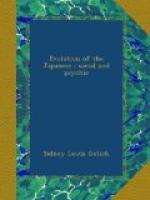Mr. Aston, characterizing Japanese literature, says:
“A feature which strikingly distinguishes the Japanese poetic muse from that of Western nations is a certain lack of imaginative power. The Japanese are slow to endow inanimate objects with life. Shelley’s ‘Cloud,’ for example, contains enough matter of this kind for many volumes of Japanese verse. Such lines as:
’From my wings
are shaken
The dews that waken
The sweet buds every
one,
When rocked to rest
On their mother’s
breast
As she dances about
the sun,’
would appear to them
ridiculously overcharged with metaphor, if not
absolutely unintelligible."[AR]
On the other hand, some writers have called attention to the contrary element of Japanese mental nature. Prof. Ladd, for instance, maintains that the characteristic mental trait of the Japanese is their sentimentality. He has shown how their lives are permeated with and regulated by sentiment. Ancestral worship, patriotism, Imperial apotheosis, friendship, are fashioned by idealizing sentiment. In our chapters on the emotional elements of Japanese character we have considered how widespread and powerful these ideals and sentiments have been and still are.
Writers who compare the Chinese with the Japanese remark the practical business nature of the former and the impractical, visionary nature of the latter.
For a proper estimate of our problem we should clearly distinguish between the various forms of imagination. It reveals itself not merely in art and literature, in fantastic conception, in personification and metaphor, but in every important department of human life. It is the tap-root of progress, as Mr. Lowell well points out. It pictures an ideal life in advance of the actual, which ideal becomes the object of effort. The forms of imagination may, therefore, be classified according to the sphere of life in which it appears. In addition to the poetic fancy and the idealism of art and literature generally, we must distinguish the work of imagination in the aesthetic, in the moral, in the religious, in the scientific, and in the political life. The manifestation of the imaginative faculty in art and in literature is only one part of the aesthetic imagination.
In studying Japanese aesthetic characteristics, we noted how unbalanced was the development of their aesthetic sense. This proposition of unbalanced development applies with equal force to the imaginative faculty as a whole. Conspicuously lacking in certain directions, it is as conspicuously prominent in others. Rules of etiquette are the products of the aesthetic imagination, and in what land has etiquette been more developed than in feudal Japan? Japanese imagination has been particularly active in the political world. The passionate loyalty of retainers to their lord, of samurai to their daimyo, of all to their “kuni,” or clan, in ancient times, and now, of the people to their Emperor, are the results of a vivid political idealizing imagination. Imperial apotheosis is a combination of the political and religious imagination. And in what land has the apotheosizing imagination been more active than in Japan? Ambition and self-conceit are likewise dependent on an active imaginative faculty.




